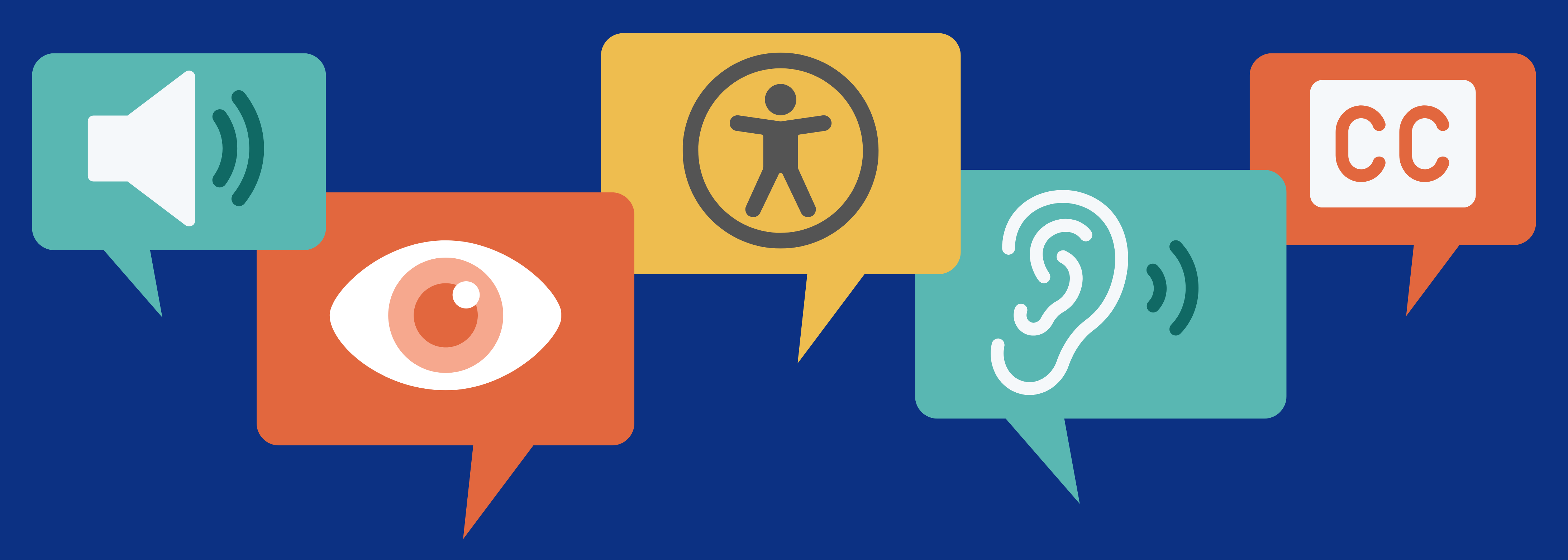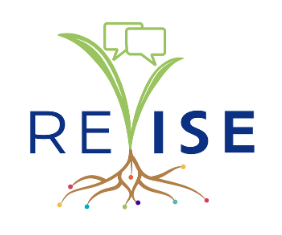
Overview
The best practices outlined in this page are borrowed from the REVISE Center’s Inclusive Communication Strategy, developed by the Center’s Communications team. This page seeks to serve as a resource for the informal STEM education field and it is intended to be updated regularly—evolving as we learn. The guiding principles outlined here are intended to serve as a roadmap to guide communication efforts and support fostering an environment where all feel acknowledged, welcomed, and empowered.
In this page you will find accessibility best practices for:
Digital and Printed Materials
Communication materials should incorporate basic digital and print accessibility elements:
- Alt-Text for Images: Include descriptive alt text for images, ensuring that screen readers can convey the information to users with visual impairments. See Harvard University’s guide to writing helpful Alt Text.
- Headings and Semantic Structure: Use proper heading tags (H1, H2, H3, etc.) to create a logical and hierarchical structure. This helps screen readers and users to understand the content hierarchy structure. See California Foundation for Independent Living Centers’ (CFILC) Microsoft PowerPoint Accessibility 101 Webinar, a presentation by their Ability Tools Program, for an example of the importance of structure to documents and presentations.
- Keyboard Accessibility: Ensure that all interactive elements, such as links and forms, are navigable and usable with a keyboard alone. Users should be able to “tab” through elements in a logical order.
- Color Contrast: Maintain sufficient color contrast between text and background to ensure readability for users with visual impairments. Follow established accessibility guidelines for contrast ratios.
- Descriptive Link Text: Use clear and descriptive link text that conveys the purpose of the link. Avoid generic terms like “click here” and provide context within the link text.
- Closed Captions and Transcription for Multimedia: Provide closed captions for videos and text transcriptions for audio to make content accessible to individuals with hearing impairments.
- Focus Styles: Implement clear and visible focus styles for interactive elements. This helps users who navigate through the content using a keyboard to see which element is currently focused. For example, a button element that changes size or color opacity when on focus or hovered over.
- Forms and Input Fields: Ensure that forms and input fields are properly labeled, and instructions are provided. Use ARIA (Accessible Rich Internet Applications) attributes when necessary.
- Consistent Navigation: Maintain a consistent and intuitive navigation structure across the website and other applications. Users should be able to easily understand and navigate through the content.
- Responsive Web Design: Design responsive web pages and elements to be responsive, automatically adjusting to appropriate sizes when viewed on varying screen sizes (e.g., larger computer screens, smaller mobile phones and tablets).
- Readable Font Size and Text Spacing: Choose readable font sizes and provide adequate spacing between lines of text. Avoid small font sizes and ensure text is easily legible. For body text, at least a 12 to 14-point font size should be used. For PowerPoint presentations, a minimum of 24-point font size should be used (See the National Disability Rights Network.)
- Testing with Accessibility Tools: Regularly test digital materials using accessibility tools and assistive technologies to identify and address any potential issues. For example, Microsoft PowerPoint and Word have an Accessibility Checker that will identify any warnings, errors, and intelligent services associated with your file that should be addressed.
- Accessible Brochures and Flyers: Design brochures and flyers with accessibility in mind, considering file format, layout, font size, and color choices to make them user-friendly for everyone.
- Printed Event Programs: Ensure that event programs are available in accessible formats, including large print and Braille versions, and communicate their availability in event promotions. Include an accessibility statement with a point of contact for accommodation needs.
Physical Resources and Spaces
When physical spaces are needed for in-person events, ensure that space/event plans adhere to the following basic physical accessibility elements:
- Accessible Signage: If applicable, include Braille and tactile signage in appropriate areas of the physical space for individuals with vision impairments. Ensure that there are enough signs to assist with navigating the space.
- Physical Spaces: Ensure that physical spaces are accessible to individuals using wheelchairs or other mobility aids, and designed with adequate space for maneuverability. This includes making sure that there are ramps, wide doorway entrances, wide aisles, and open spaces.
- Equipment and Furniture: Ensure that any equipment or presentation materials are reachable for everyone. Ensure that furniture is adjustable and accommodates different physical abilities and body-mind types. This may include desks, chairs, and tables that can be easily modified to meet specific needs. Position standard equipment at heights that ensure the controls are easily reachable.
- Scent Free: Aim to provide scent-free environments for in-person events. Certain scents—such as perfumes/colognes, deodorizers and cleaners; pesticides; wall and floor coverings; and building materials—can impact those who are neurodiverse and those who have multiple chemical sensitivities (MCS).
- Well-Lit Spaces: Maintain well-lit spaces throughout the venue to assist individuals with visual impairments and light sensitive impairments. Ensure that lighting is even and minimizes glare.
- Microphones: Ensure that various types of microphones are available and used by all presenters and audience members who share remarks intended for the whole audience/all present.
Language
Use inclusive language that respects diverse identities and experiences, and consider these basic inclusive elements:
- Cultural Sensitivity: Be mindful of cultural nuances and differences. Avoid assumptions based on someone’s cultural background. Use language that acknowledges diverse cultural backgrounds.
- Gender-Neutral Terms: Avoid gendered language, unless the person with whom you are interacting has specified their pronouns (see: Respect Pronouns). For communications that are intended for an audience (more than one person), instead of “he” or “she,” use “they” or reword copy to be gender-neutral.
- Examples:
- “everyone” or “all” instead of “ladies and gentlemen”
- “Chairperson” instead of “chairman” or “chairwoman”
- Respect Pronouns: Adopt the pronouns that individuals use to identify themselves. Include opportunities for individuals to specify their pronouns in various interactions and scenarios (etc., registrations, forms, meetings, on name tags, etc.).
- Avoid ableist metaphors, euphemisms, and other infantilizing/paternalistic language: Refer to the Disability Language Style Guide by the National Center on Disability and Journalism and the Guidelines for Writing About People With Disabilities by the ADA National Network.
- Ongoing review and improvement: Regularly review and update language across your communication materials to ensure it reflects accessibility ans inclusivity goals. Welcome input from teammates, audiences, and value-holders to guide language use and foster an environment of openness and improvement.
Written Content
Aim for written content that is clear, concise, and structured for easy comprehension by incorporating these basic elements for inclusive written content:
- Use clear, plain language: Be mindful of various cognitive abilities when drafting written content. As often as possible, use plain language in logical structure. Provide additional resources for deeper understanding and exploration when applicable. Refer to tools, such as WebAIM’s Guide to Writing Clearly and Simply, for more considerations around improving readability for diverse readers.
- Acronyms: Clearly define and/or spell out all acronyms at the first mention. When applicable, spell out acronyms in every use.
- Messaging: When possible, your messaging should remain short, simple, and direct. Avoid run-on sentences, long paragraphs, complex jargon. Aim to clarify complex ideas and jargon through plain language and the use of visual aids, such as figures and graphics with alt-text.
Multimodal Content
Leverage various communication formats, including text, images, audio, and video, to cater to diverse learning and engagement preferences. Incorporate these basic elements for inclusive multimodal content:
- Sensory Considerations: Consider sensory-friendly design features in multimedia content. Avoid flashing lights, dramatic visual effects, excessive movement that may cause discomfort or deem material inaccessible for readers/listeners/users with sensory sensitivities.
- User-Generated Content: When possible, incorporate user-generated content in various formats. Seek content that is created by members of varying communities, especially those of the communities featured in content pieces. Provide mechanisms and clear guidelines for users to contribute content that reflects their comprehension needs (as well as their perspectives).
- Technology Compatibility: Regularly test your multimodal content to ensure content is compatible with various assistive technologies, such as screen readers and speech-to-text tools.
Information Design
To support the readability and comprehension of your communication and information materials, aim to incorporate helpful information design, following basic accessibility elements for information design:
- Visual Consistency: Maintain consistent visual design, with colors, fonts, logo usage, and design elements that remain on-brand. This helps create a recognizable and cohesive brand identity. A brand style guide is helpful to maintain visual consistency.
- Icons and Imagery: Incorporate universally understood icons and imagery to supplement messages and ideas. This provides a supplementary, alternative means of comprehending information for diverse users/readers.
- Use of Infographics and Data Visualization: When appropriate, utilize infographics and data visualizations to convey complex information. Ensure that these visuals are accessible and supplement the overall message/idea.
- Presenting Data: When presenting data, prioritize clarity. Use appropriate chart types, provide clear labels, and include contextual information to aid interpretation.
- Segmented Information: Break down information into manageable segments for easier comprehension. Create visually organized layouts when presenting information. See Digital and Printed Materials > Headings and Semantic Structure.
Additional Resources
Below are some helpful resources to support the development of inclusive and accessible content and communications.
- Web Content Accessibility Guidelines (WCAG 2.2): The WCAG provides a comprehensive set of guidelines for creating accessible web content, offering clear and detailed recommendations for developers and content creators.
- Harvard University: Digital Accessibility Resources
- Plainlanguage.gov offers guidelines and resources to help create clear and easy-to-understand content. It emphasizes the use of plain language for improved accessibility.
- The A11 Project is a community-driven, open source website that offers guides, tools, resources and articles to support improved digital accessibility.
- Contrast Checker by WebAIM :This tool helps test and ensure sufficient contrast between text and background colors.
- Inclusive Design Principles (by TPGi): a guide to creating inclusive experiences, covering various elements of design and content creation.
- Accessible Rich Internet Applications (ARIA): ARIA provides information to assist with the development of accessible web applications, offering practical examples and advice.
- Color Palette Contrast Checker
- Inclusive Science Communication Starter Kit by the Metcalf Institute: This toolkit provides an introduction to techniques and strategies for inclusive science communication.
- Inclusive SciComm Resources Page of the Inclusive SciComm Symposium website: This webpage contains other resources related to the movement that are periodically updated.
- It Begins with Us: Modeling an Accessible Webinar
- Choosing a media player Harvard University: guidance on choosing an accessible media player.
- Create Accessible Google Slides Harvard University: steps to create accessible documents in the Google Workspace.
